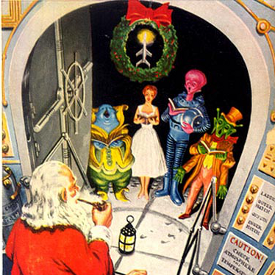
This week’s journey is into the world of fanzine heaven as conducted by Rog Phillips in the original series of The Club House columns as they first appeared in Amazing Stories back when it was still a pulp magazine. Along the way there will be several sidesteps, hopefully no missteps as we take a look at the way the true originals of First Fandom did their pubbing thing.

In keeping with this I’ve spent the last week cleaning up my library in preparation, carefully dusting off the many moldering and desiccated mimeo and hectographed fanzines contained therein. (Please don’t laugh at the state of my collection, I’ve often been told and am proud to insist that I live in a parallel universe out in a remote, very rural part of the Mohave Desert.)
To begin, let’s start with one of the very best fanzines of the late 1940s and early 1950s. (Please note: all these fanzine reviews are excerpted from my forthcoming book, The Club House, and all parenthetical remarks are my annotations!):

THE GORGON (Gorgon #6, Vol. 1, no. 6, Jan. 1948, 77 pages. Contributors are Lee Beecher, David H. Keller, Archie Musick, Shan Nosgorov, Marijane Nuttall, Robert C. Peterson, Phil Rasch (article on Abraham Merritt: “Sidelights on the Merrittales: II—The Rrrllya”), and a poem “Deserted House,” by Genevieve K. Stephens, with illustrations by Roy Hunt and Stanley Mullen, and the cover by Roy Hunt.): January issue, maintains its usual high quality. There is a Denver group of fans that hold regular meetings. They are held on Saturday evening. If you live in Denver or near there, contact Stan Mullen (Stanley Mullen has an article in this issue: “Haunted Mines,” as by Lee Beecher.) and ask about the group. It’s called the Colorado Fantasy Society.
In addition there is a short story, “The Shadow Woman,” by Shan Nosgorov; a poem, “Storms of Night,” by Mary Jane Nuttall (Mary Jane Nuttall aka Marijane Nuttall), the famous fan poetess whose poems have appeared in many different fanzines. “The Killer” is a short story by David H. Keller (David Henry Keller (23 Dec. 1880-13 July 1966) was a Pennsylvania based fan and writer. However, he was best known as a writer for the pulp magazines. But his lasting service was as a fan and booster, often financing the publication of his reprinted works under the imprint of such as Arkham House.), the great staff writer, appearing in this issue of Gorgon.
***

DREAM QUEST (Dream Quest #5, April 1948.) No. 5:—also a price boost, but perhaps the best all purpose fanzine on the market, with its subscription list just about filled up to capacity. Best article is by Art Rapp, on something called Soma, which he says is the juice of the moon planet. It has such priceless gems of expression as “No self respecting Brahmin would be caught living in a house that didn’t have a Yajnyasala in it.” The Yajnyasala is a room with a wall in it called a yajnyavedi, and on a part of this wall called the Yoni they keep a bowl full of Soma! Also something by Milt Rothman about scientists which is good fun, and plenty of other stuff.
Something extra put out by Don Wilson and his friends is Opinion (Opinion was an eight-page supplement.), the results of the Dreamland Opinionator poll which put Ed Hamilton’s (Edmond Moore Hamilton (21 Oct. 1904-1 Feb. 1977) was an American author of science fiction stories and novels during the mid-twentieth century. His career as a science fiction writer began with the publication of the short story “The Monster God of Mamurth,” which appeared in the Aug. 1926 issue of Weird Tales. His story “The Island of Unreason” (Wonder Stories, May 1933) won the first Jules Verne Prize as the best science fiction story of the year (this was the first science fiction prize awarded by the votes of fans, a precursor of the later Hugo Awards). Of note: Hamilton was married to Leigh Brackett.) “Star Kings,” (“Star Kings” by Edmond Moore Hamilton (AS, Sept. 1947).) and my own “So Shall Ye Reap!” among the top ten stories of last year. I’m very proud of that.
***
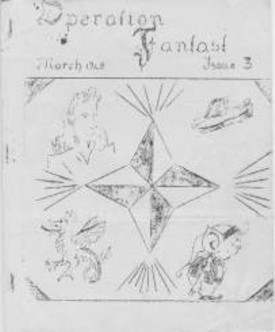
OPERATION FANTAST (Operation Fantast #3, March 1948. First series. Six issues published between Sept. 1947 through Dec. 1948.): is the official organ of the Liaison Department of the British Fantasy Library, published by Capt. K.F. Slater ((Capt.) Ken Slater (27 Dec. 1917-16 Feb. 2008) was a British science fiction fan and bookseller. In 1947, while serving in the British Army of the Rhine, he started Operation Fantast, a network of science fiction fans which had 800 members around the world by 1950 though it folded a few years later. He organized this group to get around the British exchange restrictions on stf and money just after World War II. It prospered well until Ken retired it from activity as a fan group around 1955. Ken continued as the major importer of American science fiction books and magazines into Britain through his company Fantast (Medway) up to the time of his death. He was a founding member of the British Science Fiction Association in 1938. During his early fannish career he was also a member of NFFF, Science Fiction International, British Fantasy Library, and Futurian Society of Sydney, Australia.) “at whatever place he may happen to be stationed,” at quarterly intervals. The March issue contains four short stories, a poem, general chuntering, and other departments.
***
THE ALEMBIC (The Alembic #1, April 1948. Four issues published beginning with the April 1948 issue and including Oct. 1948, Summer 1949 and Winter 1949. In March 1948 the third Operation Fantast appeared, and among its enclosures was a copy of the first issue of Norman Ashfield’s fanzine, The Alembic.): first issue, April, is a four page regalength zine by Norman Ashfield (Norman Ashfield (born 12 April 1914) was an early British fan and member of NFFF, British Fantasy League, and British Science-Fantasy Society. Early in 1953 Don Ford and the Cinci Fantasy Group started a fund to bring Anglofan Norman Ashfield to the Philcon II but he was unable to come and Don offered the funds to anyone else Anglofandom should select.) which he calls “an occasional miscellany for fantasy fans.” Norm explains that an alembic is the Alchemist’s distillation apparatus, and that he intends his zine to distill items of interest.
Norm is also connected with the British Fantasy Library, I gather.
***
And, last but by no way the least, is one of the rarest fanzine ever pubbed, it was reviewed by Rog, and contained one of his even more rare fanzine appearances. Not only that it was one of the only fanzines ever produced that he had a direct hand in creating. Quite a feat! To read his article you will either need to find an original copy, or buy my book!
***
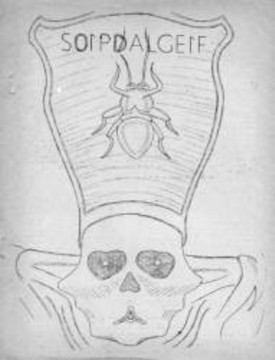
SOIPDALGEIF:
(SOIPDALGEIF #1, Jan. 1948, 5 pages, a one-shot, contains:
“SOIPDALGEIF”
By Reward
The following is the explanation for the unusual title of this one-shot fanzine, SOIPDALGEIF.
The “five great minds” were at a loss as to a name for their product. For a half hour they rested in their own heads, and it is doubtful that they were concentrated completely on concocting a title.
Then Roger Graham, who writes for Amazing Stories, who is an author, and thus who should have numerous ideas abounding in his head, solved the dilemma by picking up an evening paper containing an account of the recent assassination of Mohandas Gandhi.
He took a sharpened pencil (a pin was not available) and stabbed fiercely at the page of the account of the Indian ruler’s passing away. The shaped point of the pencil by some chance hit the letter “S”; then he did this again, while Howard Miller took down the letters. The next one was O, and the next one was I. The process was repeated the next letter struck being P; the next letter was D, the next one A, then L, then G, then E, then I, then F. When the letters were put together we found we had SOIPDALGEIF.
Thus the origination of the odd title.
SOIPDALGEIF (which name I disapprove) is a one-shot fanzine put out jointly for FAPA by Rog Phillip Graham, Howard Miller, Don Wilson, Rex Ward and Charles Burbee. It mostly happened the afternoon of Jan. 31, 1948, and was finished off and readied for distribution the next day by me. This magazine is intended to die stillborn and in this objective, at least, I believe we have succeeded.)
Five pages, is a one shot put out by Burbee, Rex Ward, Don Wilson, and Howard Miller, and myself, in honor of Howard Miller and I joining FAPA! The cover is done by Howard, who is quite an artist. The title—who knows? The last sentence in the zine is, “This magazine is intended to die stillborn, and in this objective, at least, I believe we have succeeded.”
***
Wow! All this and more, quite a treat for readers of Amazing Stories back in the 1940s and today. Let’s take a look at some of our present day (e)fanzines and see how they stack up.

Counter Clock #17: February 2014. Quarterly. 20-pages. Edited by Wolf von Witting. As Wolf tells us in his preamble, “Counter Clock is mostly about European science fiction-fandom, its history and future, sf-conventions, the art of writing and fantastic film. It wasn’t Philip K Dick’s novel which inspired to the name of this fanzine, but rather the potential usefulness of certain wingdings. But it might as well have been P.K. Dick.
“The ambition is to be quarterly regular, and steadily improving. Reports from conventions all over Europe, historical accounts and letters of comment are more than welcome.“
Of note: There is actually a downloadable soundtrack attached to this file. Just follow this link to A Handful of Infinity
Wolf kicks off this issue with “Another Town, Another Train,” which is an anecdotal retrospective look at his entry into European science fiction fandom. This is followed by a review of No Space Helmets at the Bar!, a Gerfan spin on Asimov’s Basement Bar. There is a brief review of “The Year 2013 in Cinema” mostly about Gravity and Star Trek Into Darkness. Another brief, albeit entertaining section follows about author Robert Rankin. “Three Men on a Tram” recounts the story behind the soundtrack download provided for this issue by musician Staffan Mossige-Norheim, with a notable reference to the late nineteenth-century philosopher, Nietzsche. Next is a note about “Blindpassasjer” a Norwegian TV sci-fi mini-series. It does seem by now that the European science fiction scene has grown by leaps and bounds since its inception, even exceeding that of the growth in the U.S. during the same time frame. “Open the Pub Bay Doors, Hal!” informs us about Italians favorite alcoholic beverage. There is a section “The Year 2013 on DVD” about the title subject. There are several obits, among them one for Horst Gehrmann Ewers (a Perry Rhodan author). Amidst the many reviews, such as “The Myth of September 11,” by Roberto Quaglia, this zine is peppered with many interesting personal fan-historical anecdotes. And in “LOC Around the Clock,” who should appear but Taral Wayne!, along with Rolf Strömgren, and the ever ubiquitous Lloyd Penney. Finally we reach “European Events Update” wherein the various continental conventions are listed. There is no question that this is the premiere European fanzine. It is highly recommended reading.
***
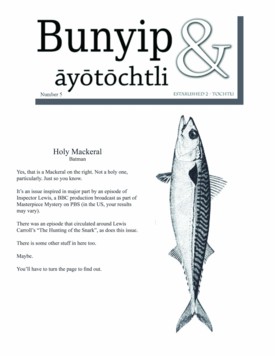
Bunyip and Ayotochtli #5: February 16, 2014. Irregular, approaching bi-weekly. 15-pages. Edited by Bob Hole. The last time I reviewed this zine I experienced several difficulties reading it online. This time I downloaded it first, making the overall experience much more pleasant. “Holy Mackeral, Batman” is Hole’s editorial hook for this ish. “The Hunting of the Snark,” by Lewis Carroll is next and is followed by “Color Your Own Paper Doll” wherein line drawings can be illustrated…. “Shakespeare Characters Word Search,” a game, comes next. Letters of Comment has one from the “semi-ubiquitous Mr. Penney”! This is an ingenious zine. One can only wonder how Bob will continue to fill up his upcoming issues at this weekly pace.
***
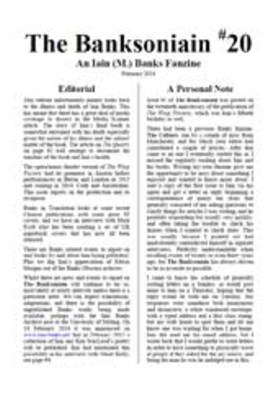
Banksoniain #20: February 2014. Bi-weekly. 12-pages. Edited by David Haddock. Subtitled: An Iain (M.) Banks Fanzine. In his editorial David explains why this zine is about all things related to Banks. It is a touching tribute zine filled with countless tidbits all about the man, from his last book, The Quarry, which appeared shortly after his death in 2013. About which Cory Doctorow described it as “a goodbye letter to the world and all of its wonder and terror.” In “Media Scanner” David recounts all the media coverage surrounding Banks’ death. The ever watchful Haddock even has a tidbit about Banks work appearing in Chinese language editions. Among the many novel appreciations of the man and his works is the production of The Wasp Factory as an Austrian opera. There is an interview with cover artist Mark Ecob. There is information about the Banks Archive, the Banks Symposium, Books about Banks, a main-belt minor planet named Iainbanks, the Banks Backlist, Banks Obscura, and the Banksoniain Calendar. I found this tribute to Banks much better done than the recent ones on PKD.
***

Littlebrook #9: May 2014. Admittedly irregular. 28-pages. Edited by Jerry Kaufman and Suzanne Tompkins (aka Suzle). Front and back covers by Stu Shiffman. Contains: “Bewitched, Bothered and Bemildred” by Kaufman, “The Fantastic Buster Keaton,” by Jim Young, “Backwaters,” by The Readers, “The Blue Light Special Cat,” by Sandra Miesel, “Suzlecol,” by Suzle. In his opening editorial Kaufman gives with a very colorful anecdotal “meet cute” with “the mighty Shiffman.” Jim Young follows with his in-depth essay on Keaton. Lots of photos attached. “Backwaters” is the letter column with gems from Mark Plummer, Hildefons Took, Milt Stevens, Kate Schaefer, Ed Meskys, Rich Lynch, the “semi-ubiquitous” Lloyd Penney, Mike Meara, Joseph Nicholas, Murray Moore, Robert Lichtman, Randy Byers, Greg Benford *yes*, John Purcell, and Gary Mattingly…basically the entire attending membership to Corflu. Sandra Miesel follows with an endearing, touching cat tale. Suzle touches bases with all of her con-running activities leading up to Corflu XXX (April 29). This is a nice little zine, compact, efficient, entertaining, and sadly…irregular. Highly recommended.
***
Well, at long last, we reach the end of this weeks’ column. Stayed tuned to Amazing Stories for the next sense of wonder filled weekly episode. If you are interested in reading the full, unedited, unexpurgated column, just follow this link to Twenty Second Century Enterprises and explore my website, dedicated to all things Rog Phillips, among others.
—Earl Terry Kemp





